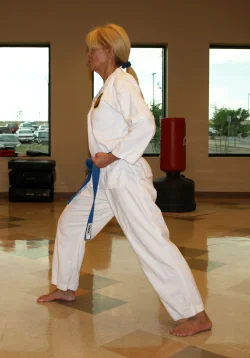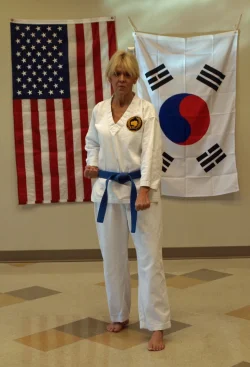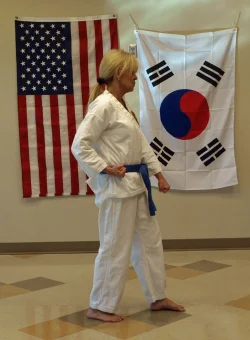Navigation
Install the app
How to install the app on iOS
Follow along with the video below to see how to install our site as a web app on your home screen.
Note: This feature may not be available in some browsers.
More options
Style variation
You are using an out of date browser. It may not display this or other websites correctly.
You should upgrade or use an alternative browser.
You should upgrade or use an alternative browser.
Front Stance vs. Walking Stance
- Thread starter Azulx
- Start date
The walking stance is shorter and more upright.
There are variations in details, so you need to check with your instructor for specifics of how the stances are done in your system.
In the Moo Duk Kwan, a front stance is done with the feet shoulder width apart both front to back and side to side. Both feet point forward, though the rear foot can be turned out as much as 30 degrees. The rear leg is locked. The front knee is bent. The weight is about 2/3 on the front leg.
The KKW front stance is the same, but only about 1/2 as wide.
The walking stance in both the Moo Duk Kwan and the KKW is upright, with the weight centered, and the feet about one foot-length apart. Basically, stand up straight and take a short step forward. That's a walking stance.
I'm not at home right now, but when I get home I can post pictures of these stances, if you like.
There are variations in details, so you need to check with your instructor for specifics of how the stances are done in your system.
In the Moo Duk Kwan, a front stance is done with the feet shoulder width apart both front to back and side to side. Both feet point forward, though the rear foot can be turned out as much as 30 degrees. The rear leg is locked. The front knee is bent. The weight is about 2/3 on the front leg.
The KKW front stance is the same, but only about 1/2 as wide.
The walking stance in both the Moo Duk Kwan and the KKW is upright, with the weight centered, and the feet about one foot-length apart. Basically, stand up straight and take a short step forward. That's a walking stance.
I'm not at home right now, but when I get home I can post pictures of these stances, if you like.
Earl Weiss
Senior Master
Are youi KKW, ITF / Chang Hon or something else. As DD says, depends on the system.
In General Choi's 1965 Book the stance was called "Front" In the 1972 edition and later it was called "Walking" There is no difference if you are doing the Chang Hon / ITF system. The proper current terminology would be "Walking" .
In General Choi's 1965 Book the stance was called "Front" In the 1972 edition and later it was called "Walking" There is no difference if you are doing the Chang Hon / ITF system. The proper current terminology would be "Walking" .
Jaeimseu
3rd Black Belt
There are other differences between English and Korean terminology, as well. I believe the English translation for apkubi is forward inflection stance, when (at least in the US) I've always heard front stance. Another confusing one is "bandae jirugi" which is usually translated as "reverse punch," but in Korea it is a punch using the front hand (right hand in a right front stance). The non-Koreans in our club get confused when one of our Korean instructors uses the English term.The confusion is further exacerbated by the fact that in Kukkiwon/WTF-style, in English we say Walking Stance, whereas the Korean is Ap Seogi ("front stance").
Sent from my iPhone using Tapatalk
Are youi KKW, ITF / Chang Hon or something else. As DD says, depends on the system.
In General Choi's 1965 Book the stance was called "Front" In the 1972 edition and later it was called "Walking" There is no difference if you are doing the Chang Hon / ITF system. The proper current terminology would be "Walking" .
We do Ch'ang Hon forms with a heavy ITA influence, along with minor changes my instructor has made. We do not have a walking stance, we use a front stance. I was reading the Taekwon-do Encyclopedia by Stuart Anslow and was seeing that they called the front stances walking stances. Then I was doing some research on the Tageuk patterns and saw that what they called a walking stance was a much shorter looking stance. This stance kind of looks like the picture displayed by Dirty Dog. So I was seeing what was the difference between the two, by asking the world of experienced on this forum.
Earl Weiss
Senior Master
If you do the Chang Hon patterns and follow those parameters the basic standard (Which individual physiological parameters will cause to vary) is Length of stance is 1.5 Shoulders width from tip of big to to tip of big toe. Shoulder width from center of instep to center of instep. Back legged locked with foot pointing about 25 degrees forward, and front knee bent with shin slightly back angle from vertical so front of kneecap is aligned with back of front foot heel. At the end of the day you need to follow what your instructor or org technical director specifies.
There are other differences between English and Korean terminology, as well. I believe the English translation for apkubi is forward inflection stance, when (at least in the US) I've always heard front stance. Another confusing one is "bandae jirugi" which is usually translated as "reverse punch," but in Korea it is a punch using the front hand (right hand in a right front stance). The non-Koreans in our club get confused when one of our Korean instructors uses the English term.
The Kukkiwon textbook does have ap suhgi translated as "forward stance" and ap gubi as "forward inflection stance", but those aren't intuitive names in English, especially for children. When you say "walking stance", it's pretty obvious just from the name what it should look like.
Jaeimseu
3rd Black Belt
I agree. I suspect they didn't ask for/ignored suggestions from native English speakers.The Kukkiwon textbook does have ap suhgi translated as "forward stance" and ap gubi as "forward inflection stance", but those aren't intuitive names in English, especially for children. When you say "walking stance", it's pretty obvious just from the name what it should look like.
Sent from my iPhone using Tapatalk
I agree. I suspect they didn't ask for/ignored suggestions from native English speakers.
Sent from my iPhone using Tapatalk
The Kukkiwon textbooks are very helpful, but yeah. I think it's clear at many points in the English translation that they didn't consult with a native English speaker.
Similar threads
- Replies
- 63
- Views
- 6K




